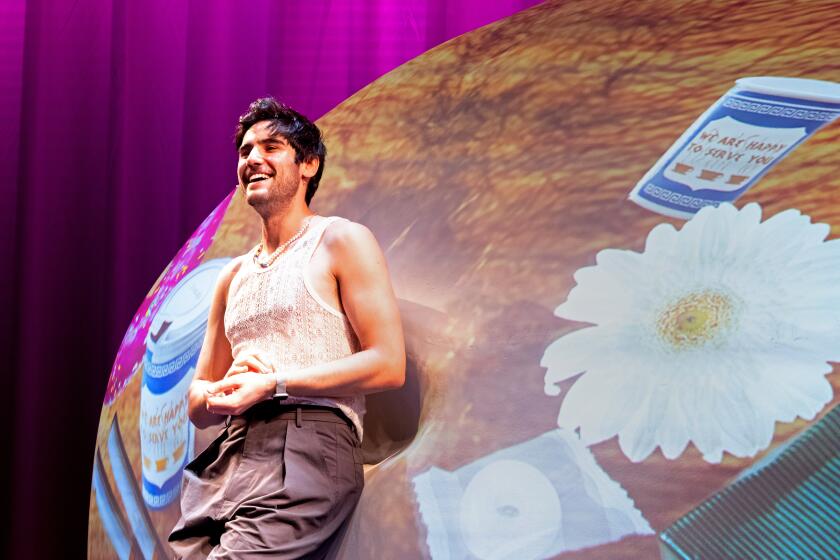The Shows May Be Over, but the Images Linger On : Television: The Museum of Broadcasting’s festival next month will salute Jack Paar, Bob Hope, Bart Simpson and Grant Tinker.
Reading in a recent Sunday Calendar the bill of fare for this year’s Museum of Broadcasting Television Festival at the Los Angeles County Museum of Art, you realize all over again how thoroughly the medium has saturated the national memory, imagination and perception of the world.
The festival, here for the eighth year, runs from March 6-23 and honors everyone from Bart Simpson (his voice, Nancy Cartwright, appears as part of a tribute to the show on March 7) to Bob Hope (appearing as the closing-night attraction).
Commercials, which constitute such a large percentage of television viewing and which, it is remarked with some justice, are often livelier than the shows they punctuate, get a show of their own this year--a tribute (March 15 at 7 p.m.) to Joe Sedelmaier, not a household name but the man who gave us “Where’s the beef?” and the fast-talker for Federal Express.
Seeking itself to be entertaining, the festival majors almost exclusively in entertainment product. The nearest nod to reality is a program honoring Ken Burns (March 9 at 9:30 p.m.), with glimpses not only of his majestic “The Civil War” but also from “The Congress,” “Huey Long” and “The Shakers.”
The Persian Gulf hostilities, the most significant challenge to television’s capabilities (in words as well as images) since Vietnam, are a grim if engrossing reminder that the medium does not live by sitcoms alone and that news and public affairs are part of the museum’s preservationist mandate.
“Anchors in Peril,” “A Treasury of Outrage From ‘Meet the Press’ ” and “Great Moments From GOP Conventions” would make lively watching. So, more seriously, would a tribute to the cameramen, hamstrung this time, who have put their lives at risk, as the newsreel guys and the still photographers did in World War II, to capture battles and landings, riots and civil insurrections.
On its own terms, the festival forces home the truth that, in our collective memory, television is like a bulletin board from which the old notices are never removed. Leafing through the past stirs recollections and evokes images you had thought were gone forever.
I note, for example, that Jack Paar gets an evening of his own (March 14 at 8), and I suspect he will volunteer or surely be asked about the night he stalked off his own show in high dudgeon, which was very high as dudgeons go, and did not stop until he reached Hong Kong.
“The Tonight Show” is a phenomenon within the larger phenomenon of television. It continues to be proof beyond all doubt that the television camera is an X-ray, from which no secrets of personality can be concealed.
It was fashionable in his “Tonight” days (1962-65) to ask what Jack Paar was really like. But if you didn’t know what the Paar persona was after your nightly exposure, you were never going to know. He was probably the most transparent of the “Tonight” hosts--quick-witted but insecure, which led to the occasional outbursts and flight, sentimental and awed in the presence of his idols (there was a memorable evening with Dorothy Parker).
After the jazz-flavored sounds of the Steve Allen “Tonight,” Allen having been the founding, formulating father of the show, the tinkling tunes of Jose Melis on the Paar edition were a change--a revealing change, since the show reveals if nothing else the tastes of the proprietor.
No one ran the show with such fearless spontaneity as Steve Allen, no one surrendered quite so totally to the camera’s penetrating vision as Jack Paar, no one has managed to be at once so affable and so private as Johnny Carson. One day, perhaps when Carson has strolled through the curtain for the last time and turned the water carafe over to Jay Leno, as seems to be the prospect, perhaps the museum can get all three hosts together for an evening to compare triumphs and catastrophes. Now that would be something.
There are otherwise tributes to Carol Burnett; Grant Tinker; Jane Fonda in that superb social drama “The Dollmaker”; the original 1953 television version of “Marty”; the 1972 tear-jerker about black and white football players, one fatally ill, “Brian’s Song,” and as they say, much else from the museum’s memory bank, and ours.
The museum’s festival has become a kind of Super-Emmy award, not an honor per se, but an acknowledgement that the shows and personalities may be transient on the air but stay with us all our days.
Information: (213) 480-3232.
More to Read
The biggest entertainment stories
Get our big stories about Hollywood, film, television, music, arts, culture and more right in your inbox as soon as they publish.
You may occasionally receive promotional content from the Los Angeles Times.










